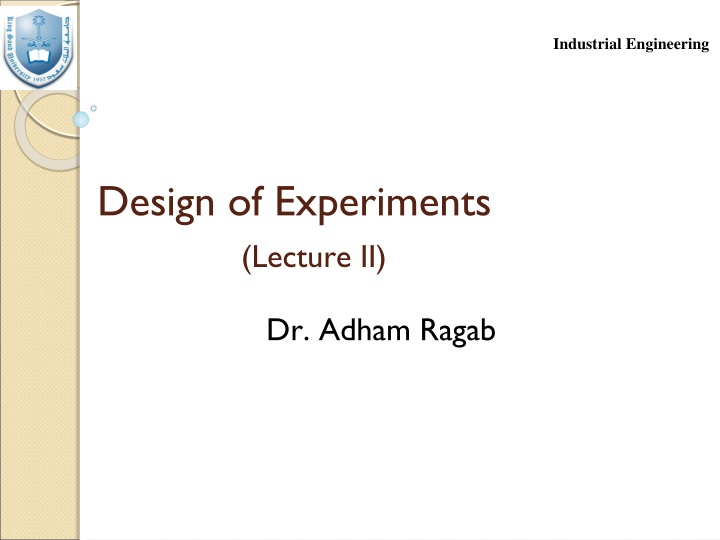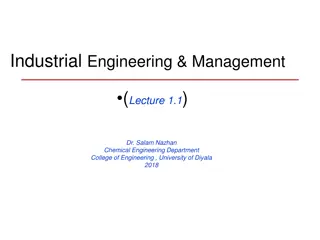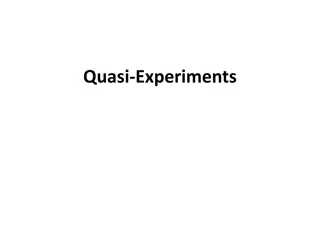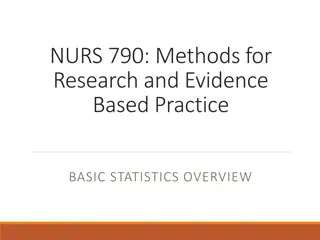Introduction to Industrial Engineering Statistics and Experiments
Delve into the realm of Industrial Engineering through Statistics and Design of Experiments in this comprehensive lecture series by Dr. Adham Ragab. Explore the practical applications of statistics, differentiate between population and sample, calculate statistical variables, and understand the significance of conducting studies to draw meaningful conclusions from data. Discover how statistics impact various aspects of life such as finance, legal systems, and healthcare. Uncover the nuances of variables and experiments in industrial engineering research.
Download Presentation

Please find below an Image/Link to download the presentation.
The content on the website is provided AS IS for your information and personal use only. It may not be sold, licensed, or shared on other websites without obtaining consent from the author.If you encounter any issues during the download, it is possible that the publisher has removed the file from their server.
You are allowed to download the files provided on this website for personal or commercial use, subject to the condition that they are used lawfully. All files are the property of their respective owners.
The content on the website is provided AS IS for your information and personal use only. It may not be sold, licensed, or shared on other websites without obtaining consent from the author.
E N D
Presentation Transcript
Industrial Engineering Design of Experiments (Lecture II) Dr. Adham Ragab
Industrial Engineering Outline Review of simple statistics
Industrial Engineering Objectives By the end of this lecture the student should be able to: Recognize the applications of statistics in real life Define the terms Population and Sample Define and calculate different statistical variables (mean, standard deviation, median, etc.)
Industrial Engineering Statistics is the science of conducting studies to collect, organize, summarize, analyze, present, interpret and draw conclusions from data. Any values (observations or measurements) that have been collected 4
Industrial Engineering Statistics in Our Life Finance Crimes and legal system Medical Quality Etc. https://www.youtube.com/watch?v=jbkSRLYSojo
Industrial Engineering Statistical Lies http://www.physics.csbsju.edu/stats/display .html
Industrial Engineering Statistical Lies
Industrial Engineering Statistical Lies
Industrial Engineering Definitions Following slides are copied from different resources
Industrial Engineering Variables A variable is a characteristic or condition that can change or take on different values. Most research begins with a general question about the relationship between two variables for a specific group of individuals. 10
Industrial Engineering Experiments The goal of an experiment is to demonstrate a cause-and-effect relationship between two variables; that is, to show that changing the value of one variable causes changes to occur in a second variable. 11
Industrial Engineering Types of Variables Variables can be classified as discrete or continuous. Discrete variables (such as class size) consist of indivisible categories, and continuous variables (such as time or weight) are infinitely divisible into whatever units a researcher may choose. For example, time can be measured to the nearest minute, second, half-second, etc. 12
Industrial Engineering Population The entire group of individuals is called the population. For example, a researcher may be interested in the relation between class size (variable 1) and academic performance (variable 2) for the population of third-grade children. 13
Industrial Engineering Sample Usually populations are so large that a researcher cannot examine the entire group. Therefore, a sample is selected to represent the population in a research study. The goal is to use the results obtained from the sample to help answer questions about the population. 14
Industrial Engineering Simple random sample A simple random sample(SRS) of size n is a sample chosen by a method in which each collection of n population items is equally likely to comprise the sample, just as in the lottery.
Industrial Engineering Independent Items The items in a sample are independent if knowing the values of some of the items does not help to predict the values of the others. Items in a simple random sample may be treated as independent in most cases encountered in practice. The exception occurs when the population is finite and the sample comprises a substantial fraction (more than 5%) of the population.
Industrial Engineering Descriptive Statistics Descriptive statistics are methods for organizing and summarizing data. For example, tables or graphs are used to organize data, and descriptive values such as the average score are used to summarize data. A descriptive value for a population is called a parameter and a descriptive value for a sample is called a statistic. 18
Industrial Engineering Inferential Statistics Inferential statistics are methods for using sample data to make general conclusions (inferences) about populations. Because a sample is typically only a part of the whole population, sample data provide only limited information about the population. As a result, sample statistics are generally imperfect representatives of the corresponding population parameters. 19
Industrial Engineering Sampling Error The discrepancy between a sample statistic and its population parameter is called sampling error. Defining and measuring sampling error is a large part of inferential statistics. 20
Industrial Engineering Types of Data Numerical or quantitative if a numerical quantity is assigned to each item in the sample. Continuous: Height Weight Age Discrete Number of students in class Number of equipment in a project
Industrial Engineering Types of Data Categorical or qualitative if the sample items are placed into categories (always discrete) Nominal (if there is no natural order between the categories) Gender Hair color Zip code Ordinal (if an ordering exists) Customer satisfaction surveys. Students grades.
Industrial Engineering Summary Statistics Sample Mean: n 1 n = X X i = 1 i Sample Variance: n n 1 1 ( ) 2 = = 2 2 i 2 s X X X nX i 1 1 n n = = 1 1 i i Sample standard deviation is the square root of the sample variance.
Industrial Engineering Definition of a Median The median is another measure of center, like the mean. To find it: If n is odd, the sample median is the number in n+ 1. position 2 If n is even, the sample median is the average n n+ of the numbers in positions and 1. 2 2
Industrial Engineering Summary Importance of statistics. Population versus sample. Mean, median and standard deviation.























